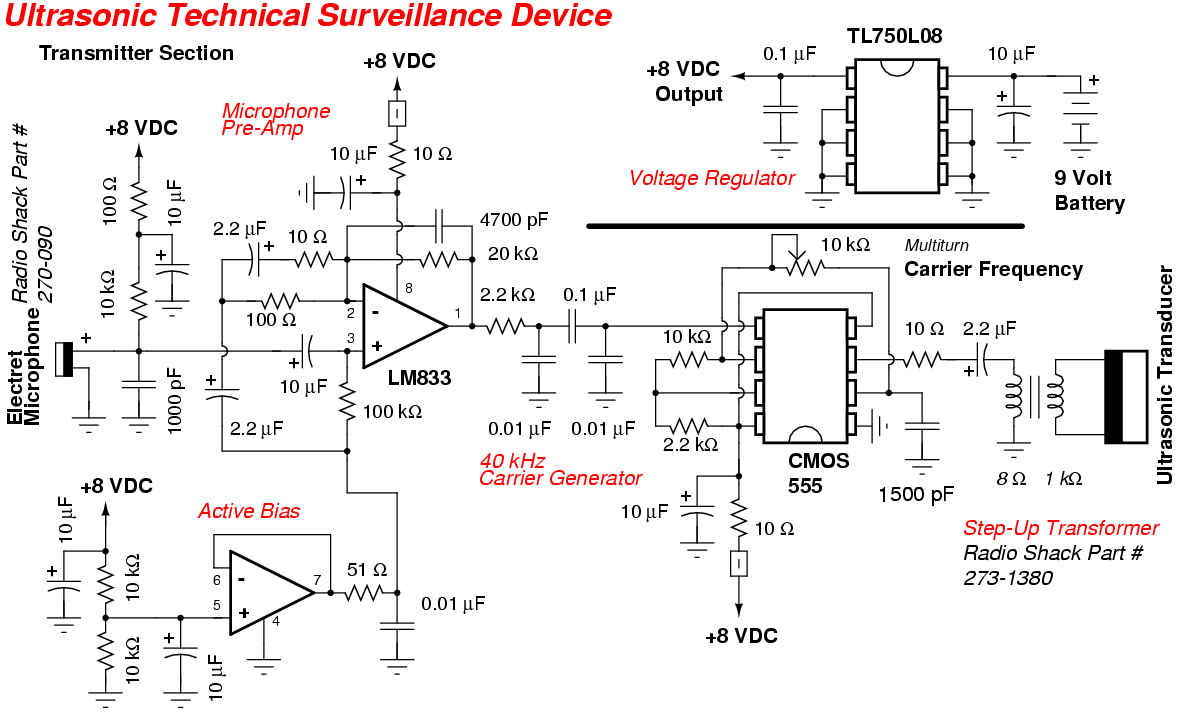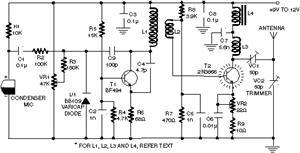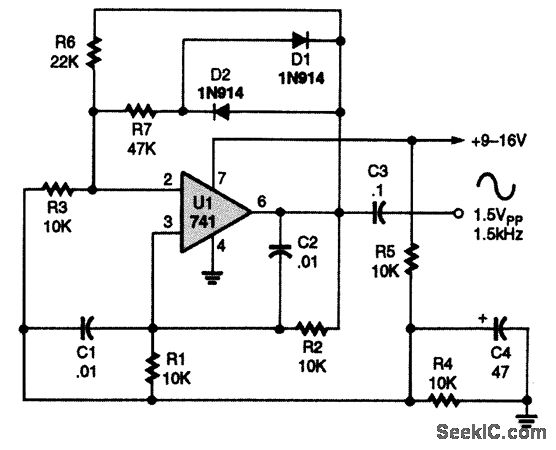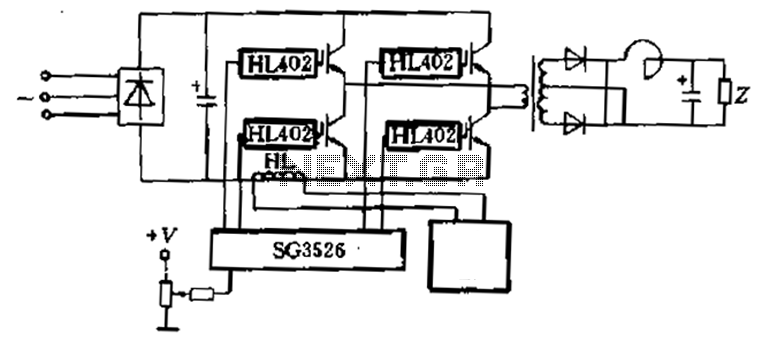
915MHz Power Amplifier RF2155 circuit diagram
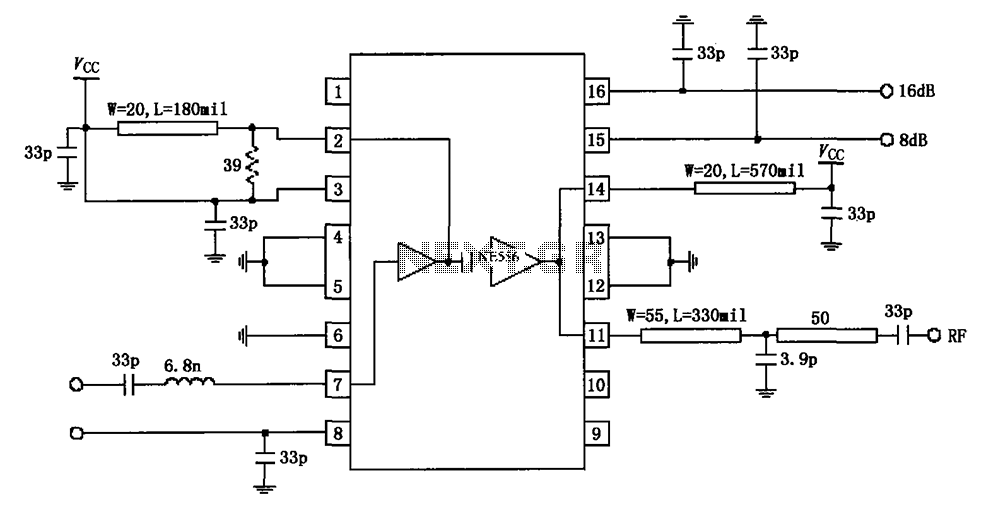
The circuit diagram illustrates the application of a 915MHz RF2155 power amplifier. The radio frequency (RF) signal enters through pin 7, where it is processed by a preamplifier. The output from the preamplifier is further amplified by the power amplifier, achieving an amplification of 11 dB. Pin 7 is directly coupled to the internal amplifier, and it is recommended to include UHF blocking coupling capacitors at this pin. The circuit supports four possible gain settings, and a series inductance of 6.8 nH is connected at the input. The final power amplifier (PA) has a mismatch collector transistor output at pins 11 and 14, with pin 14 serving as the power supply terminal for the final stage amplifier. This pin provides the necessary bias current to the amplifier. Additionally, pin 14 functions as a secondary harmonic filter circuit, effectively shorting the second harmonic using transmission lines with approximately 500 mils of inductance and 33 pF of capacitance. A tantalum capacitor may be placed near Vcc for additional filtering. Pin 8 serves as the power control pin (PC), allowing control over the amplifier's power supply. When the voltage at this pin is low (0V), the amplifier is turned off; conversely, when the voltage is high (3V), the amplifier operates at full power. An external UHF or HF filter capacitor can be connected to pin 8. Pins 15 and 16 are designated for RF power gain control, enabling adjustment of output power gain in 8 dB and 16 dB steps. The voltage at these pins must remain between 2.7V and 3.3V and should be accompanied by an external UHF bypass capacitor.
The RF2155 power amplifier circuit is designed for efficient amplification of 915MHz RF signals, making it suitable for various wireless communication applications. The architecture incorporates a preamplifier to enhance the input signal before it reaches the power amplifier stage, ensuring optimal performance and signal integrity. The choice of gain settings allows for flexibility in applications requiring different output power levels, accommodating various operational environments.
The circuit's design includes critical components such as UHF blocking capacitors and a secondary harmonic filter, which are essential for maintaining signal quality by minimizing unwanted harmonics that could interfere with the desired RF signal. The use of transmission lines in the harmonic filter design is a common practice, as it offers a compact solution for filtering while maintaining the necessary inductance and capacitance values.
Power control features are integrated into the design, allowing for dynamic adjustment of the amplifier's operational state based on the voltage applied to pin 8. This capability is particularly useful in battery-operated devices, where power conservation is a priority. The gain control terminals at pins 15 and 16 provide additional versatility, enabling precise control over the output power levels, which can be critical in applications where signal strength must be carefully managed.
Overall, the RF2155 power amplifier circuit is a well-engineered solution for RF amplification, combining flexibility, efficiency, and effective harmonic management, making it suitable for a range of 915MHz applications. As shown in FIG constituted by 915MHz RF2155 power amplifier application circuit. Radio frequency (RF) signal from the input pin 7, after the preamplifier, after the last stage power amplifier output is amplified by 11 feet. 7 feet and the internal amplifier is directly coupled, it is proposed in 7 feet plus a UHF blocking coupling capacitors. Since there are four possible gain settings, so a series with the input 6.8nH inductance. Final PA is a mismatch collector transistor output terminal 11 feet and 14 feet are connected inside the chip, 14 feet as the final stage amplifier power supply terminal, providing a bias current through these pins to the final amplifier.
14 feet as a secondary harmonic filter circuit, effectively shorting the second harmonic, using transmission lines as about 500mils inductance and 33pF capacitance of the filter (near Vcc may be placed at a tantalum capacitor). 8 feet to power control pin (PC), you can control the pin voltage to control the power supply. When the voltage is low (0V), the amplifier power supply is turned off; when the voltage is high (3V), the amplifier is in full power operation.
8-pin external UHF or HF filter capacitor. 15 and 16 feet for the RF power gain control terminal, control the output power gain of 8dB bit step and 16dB bit step, these feet high at least 2.7V, shall not exceed 3.3V, while an external UHF bypass capacitor.
The RF2155 power amplifier circuit is designed for efficient amplification of 915MHz RF signals, making it suitable for various wireless communication applications. The architecture incorporates a preamplifier to enhance the input signal before it reaches the power amplifier stage, ensuring optimal performance and signal integrity. The choice of gain settings allows for flexibility in applications requiring different output power levels, accommodating various operational environments.
The circuit's design includes critical components such as UHF blocking capacitors and a secondary harmonic filter, which are essential for maintaining signal quality by minimizing unwanted harmonics that could interfere with the desired RF signal. The use of transmission lines in the harmonic filter design is a common practice, as it offers a compact solution for filtering while maintaining the necessary inductance and capacitance values.
Power control features are integrated into the design, allowing for dynamic adjustment of the amplifier's operational state based on the voltage applied to pin 8. This capability is particularly useful in battery-operated devices, where power conservation is a priority. The gain control terminals at pins 15 and 16 provide additional versatility, enabling precise control over the output power levels, which can be critical in applications where signal strength must be carefully managed.
Overall, the RF2155 power amplifier circuit is a well-engineered solution for RF amplification, combining flexibility, efficiency, and effective harmonic management, making it suitable for a range of 915MHz applications. As shown in FIG constituted by 915MHz RF2155 power amplifier application circuit. Radio frequency (RF) signal from the input pin 7, after the preamplifier, after the last stage power amplifier output is amplified by 11 feet. 7 feet and the internal amplifier is directly coupled, it is proposed in 7 feet plus a UHF blocking coupling capacitors. Since there are four possible gain settings, so a series with the input 6.8nH inductance. Final PA is a mismatch collector transistor output terminal 11 feet and 14 feet are connected inside the chip, 14 feet as the final stage amplifier power supply terminal, providing a bias current through these pins to the final amplifier.
14 feet as a secondary harmonic filter circuit, effectively shorting the second harmonic, using transmission lines as about 500mils inductance and 33pF capacitance of the filter (near Vcc may be placed at a tantalum capacitor). 8 feet to power control pin (PC), you can control the pin voltage to control the power supply. When the voltage is low (0V), the amplifier power supply is turned off; when the voltage is high (3V), the amplifier is in full power operation.
8-pin external UHF or HF filter capacitor. 15 and 16 feet for the RF power gain control terminal, control the output power gain of 8dB bit step and 16dB bit step, these feet high at least 2.7V, shall not exceed 3.3V, while an external UHF bypass capacitor.

